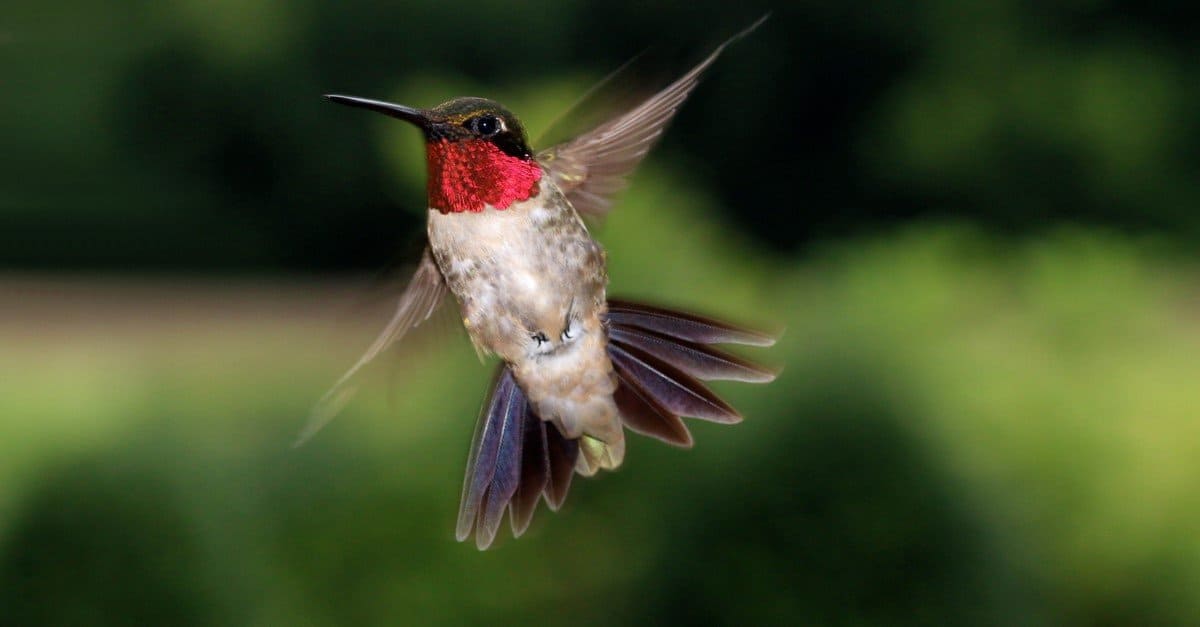Hummingbirds are fascinating little birds found all over the Americas. They are known for their beautiful colors, aerial acrobatics, and lightning-fast speeds. But did you know that hummingbirds can outpace a space shuttle? Or that hummingbirds are close to starvation every single day? Keep reading to learn about these and more incredible hummingbird facts!

10. Hummingbirds Steal From Spiders

A hummingbird builds its nest with spider silk, leaves, twigs, and grasses.
©Agnieszka Bacal/Shutterstock.com
The hummingbird loves to steal silk from spider webs. Why? Because hummingbirds use these sticky webs to build their nests. The female will line her nest with sticky silk, which helps to keep the eggs safe and secure. Unfortunately for the spiders, this destroys their webs.
Hummingbirds use other materials to build their nests include leaves, bark, grasses, and twigs. The female hummingbird weaves these materials to create a soft, cozy home for her eggs. She often uses spider silk to help bind these materials together.
Hummingbirds are amazing creatures, and their nests are a testament to their engineering skills!
9. Hummingbirds Nearly Starve Every Day
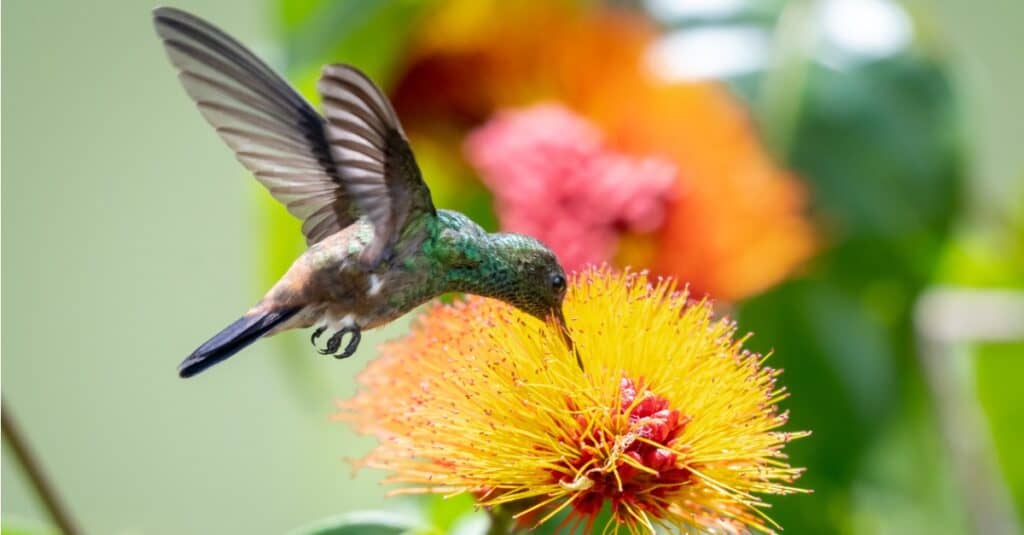
A hummingbird is a nectar-eating machine.
©iStock.com/Chelsea Sampson
A hummingbird will starve to death if it doesn’t eat many times a day. This constant state of near-starvation is because hummingbirds burn up so much energy so quickly that they must eat every 10-15 minutes. If they don’t, they will die.
Hummingbird metabolism is twice much faster than any other animal on Earth. It’s 100 times faster than an elephant‘s metabolism! And a hummingbird’s metabolism is more than 77 times faster than human metabolism. Plus, this tiny bird has the highest body temperature of any warm-blooded animal (nearly 106 degrees Fahrenheit), and its heart beats 1,260 times per minute. To fuel their rapid metabolism, hummingbirds eat about half their body weight in sugar every day.
Nectar is primarily sugar water, so it’s an important food source for hummingbirds. But nectar alone doesn’t provide all the nutrients a hummingbird needs. So they also eat small insects for protein. A diet of only nectar would be like a human eating nothing but candy. It might taste good, but it wouldn’t be very nutritious!
At night, a hummingbird’s metabolism slows down into a state of torpor, allowing the bird to eat less than it does during daylight hours. That’s a good thing because if a hummingbird ate as much at night as it does during the day, it would probably explode!
8. Hummingbirds Are the Only Birds That Fly Backward
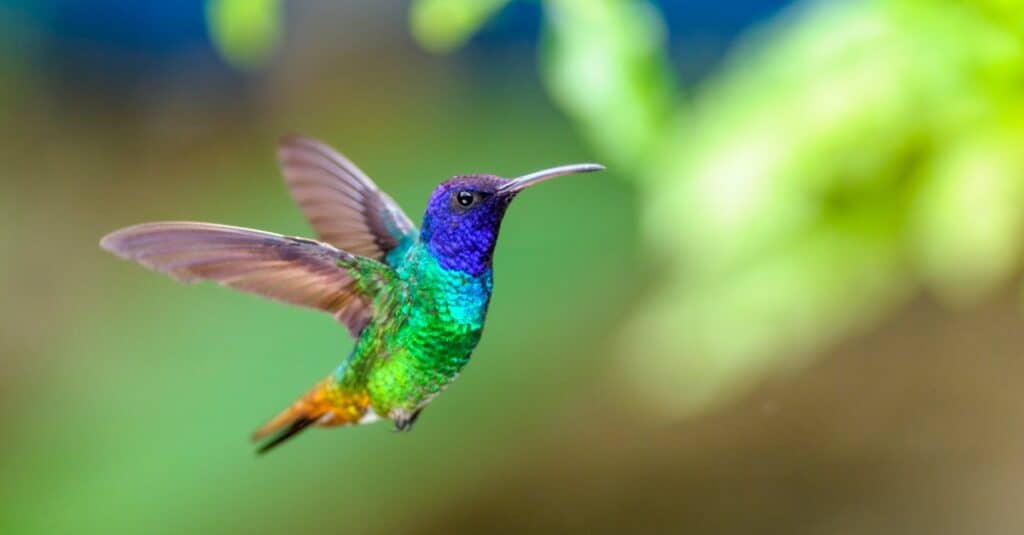
This hummingbird flies backward because of its unique anatomy.
©iStock.com/photofxs68
Most birds can fly forward, but hummingbirds are the only ones that can fly backward. So how do they do it?
It’s all thanks to their ball and socket shoulder joints, the rapid pace of their wing beats, and their unique wing patterns. Hummingbirds’ shoulder sockets allow their wings to move 180 degrees in all directions, including backward. In addition, this bird’s wing beats clock-in at around 70 times per second while flying. That speed gives its backward motion stability and strength. The hummingbird’s wings rotate in a figure-eight pattern as they hover and an oval pattern when they fly. This ability gives their wings extra lift and allows hummingbirds to change directions quickly and easily.
7. Hummingbirds Outpace Space Shuttles
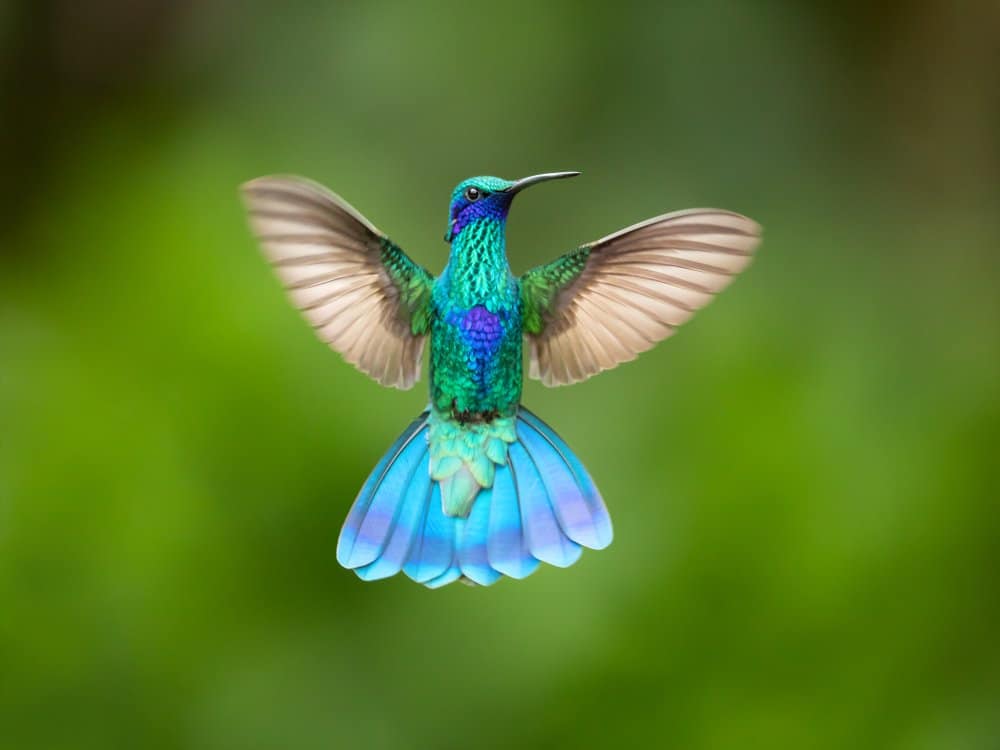
A hummingbird can dive at speeds up to 385 body lengths per second.
©Milan Zygmunt/Shutterstock.com
Hummingbirds are the fastest animals in the world when it comes to speed based on body lengths per second (BL/s). These miniature birds are so fast that they outpace a space shuttle! For example, when a space shuttle races back to Earth, its speed is just over 200 BL/s. However, a diving hummingbird flies up to 385 BL/s! The speed of a diving hummingbird also outpaces a fighter jet, which flies at about 150 BL/s.
Hummingbirds can achieve that kind of pace because they fly up to 60 miles per hour. We’ve already learned that their wings beat 70 times per second while flying. But did you know their wings beat up to 200 times per second while in a dive? It’s true! The hummingbird’s small size and low weight help them achieve these high speeds.
Also, the hummingbird’s wing muscles make up 25% of their total body weight. This percentage is much higher than other birds, which typically have wing muscles that make up only 10% of their body weight. All that wing muscle makes hummingbirds a strong flying force in the sky!
Another advantage hummingbirds have for flying and diving is that their wings are longer and thinner in proportion to their width. These features help them fly faster and make sharper turns.
6. Hummingbirds Are Nasty Neighbors
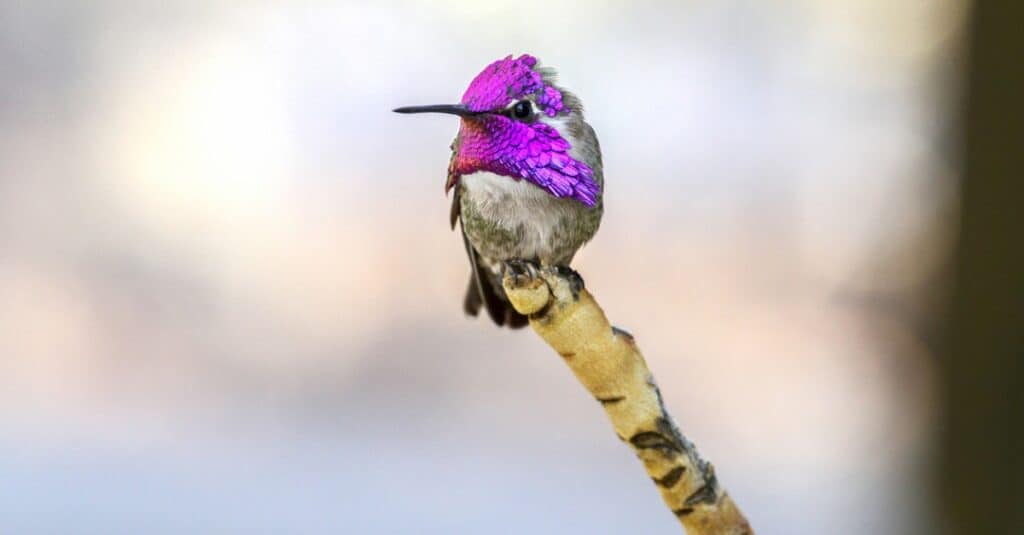
Always on the watch for intruders, hummingbirds are very territorial.
©iStock.com/Monica Lara
Hummingbirds can be very territorial, especially regarding their food sources. They will swoop down and attack other hummingbirds that come into their personal space. Hummingbirds also chase away other birds, insects, and even mammals that come too close to their feeding areas.
This behavior is likely because hummingbirds need a lot of energy to keep up their high metabolism, and they can’t afford to share their food with anyone. Hummingbirds will also take nectar from other birds’ nests when the need arises.
The males are the most territorial because they are trying to protect their mates and nesting areas. The females are not as aggressive but will still defend baby hummingbirds.
Due to their territorial (and vulnerable to predators) nature, hummingbirds usually build their nests in sheltered locations near sources of food. Isolated trees, bushes, and structures like covered decks are just a few examples of common hummingbird nesting grounds.
Did you know that hummingbirds often sleep while hanging upside down in a tree? Consider that a bonus incredible fact about hummingbirds we think is really cool!
5. Hummingbirds Are the Smallest Birds Worldwide
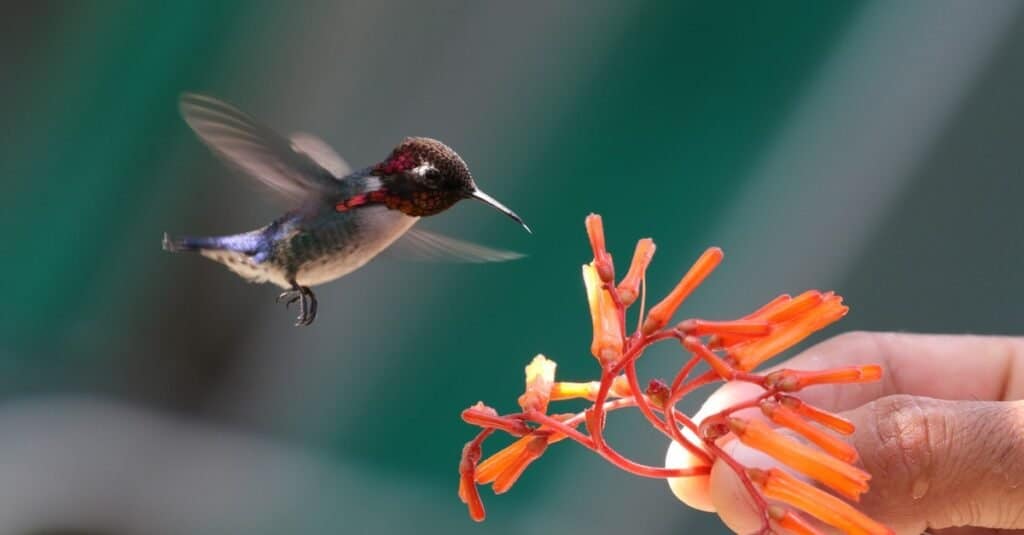
Bee hummingbirds are the tiniest birds known to man.
©James Bloor Griffiths/Shutterstock.com
The Bee Hummingbird is the tiniest bird known to man, with a length of just 2.25 inches (5.7 centimeters) and a weight of 0.07 ounces (2 grams). All hummingbirds are among the smallest birds in the world, with most species measuring 3-4 inches in length. Its tiny size gives it a few advantages and disadvantages.
One advantage of being the smallest birds in the world is that hummingbirds can build their teensy nests just about anywhere. A hummingbird’s nest is only one or so inches in diameter! Their small size also makes it easier for them to fly to sources of food and feed their young quickly.
There are a few disadvantages to being small, too. For example, hummingbirds have difficulty staying warm in cold weather, and they can’t carry much food or nest-building supplies at a time. Also, they aren’t much of a match against gale-force winds. Their little bodies with big hearts require eating constantly.
4. A Hummingbird’s Heart Is Huge for Its Body
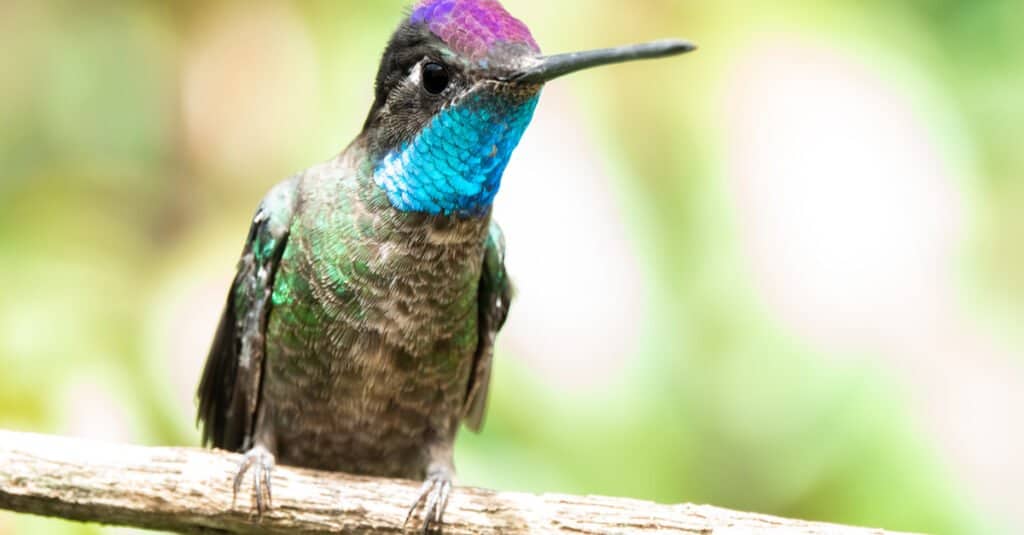
A hummingbird’s heart is quite large compared to its tiny body.
©Jeroen Mikkers/Shutterstock.com
Hummingbirds have hearts the size of pencil erasers, but that’s a massive size for such small bodies. The hummingbird’s heart makes up about 2.5% of its total body weight. By comparison, that’s about 10 times the percentage for humans.
So why do hummingbirds have such big hearts? The answer has to do with flying. Hummingbirds fly a lot, and flight takes a lot of energy. Hummingbirds are always just a few wingbeats away from a heart attack. Their hearts have to work very hard to pump blood to their wings consistently.
The hummingbird’s heart beats up to 1,260 times per minute. That’s more than 20 times per second! And when they’re flying, their heart rate can increase to more than 1,400 beats per minute.
While we humans might think that a heart rate over 1,000 beats per minute would be dangerous, for hummingbirds, it is perfectly normal and helps them to survive in the wild. Their high heart rates also give them the ability to fly at high speeds and impressive perform aerial feats!
3. Hummingbirds Don’t Live in the Eastern Hemisphere
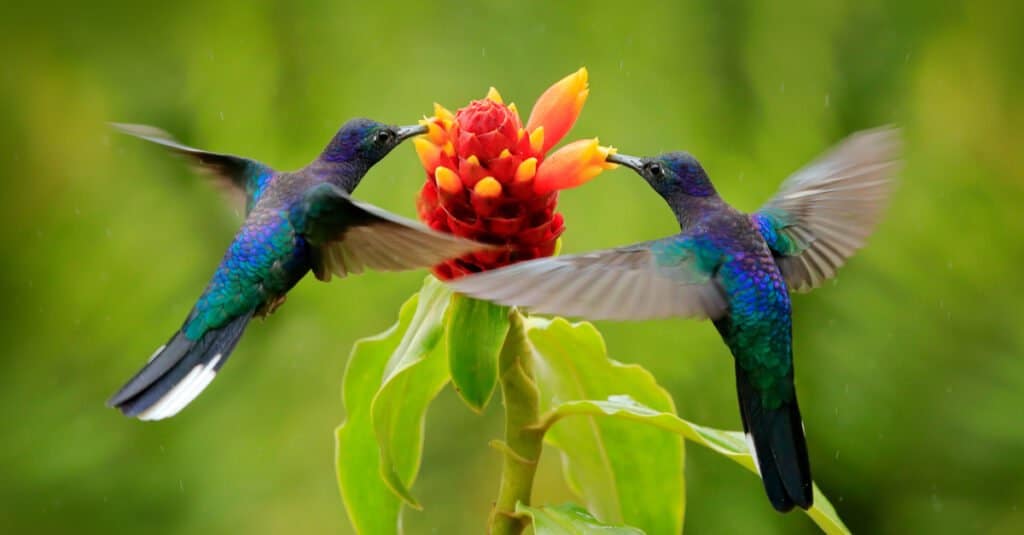
There are more hummingbirds in Central and South America than in North America.
©Ondrej Prosicky/Shutterstock.com
There are nearly 340 hummingbird species in the world, but none of them lives in the Eastern Hemisphere. Instead, the vast majority of hummingbird species (more than 320) live in the Western Hemisphere, with the bulk of those species living in Central and South America.
Only a few species live in North America, and even fewer live in Europe, Africa, or Asia. The reasons for this distribution are not entirely clear. Still, it is likely because the flowers that hummingbirds feed on are more abundant in the Western Hemisphere.
There are also more insects for hummingbirds to eat in the Western Hemisphere, which is important because they need protein to survive. So if you want to see a hummingbird, you’ll have to travel to the Americas!
2. Hummingbirds Drink Their Dinner (And Breakfast. And Lunch.)
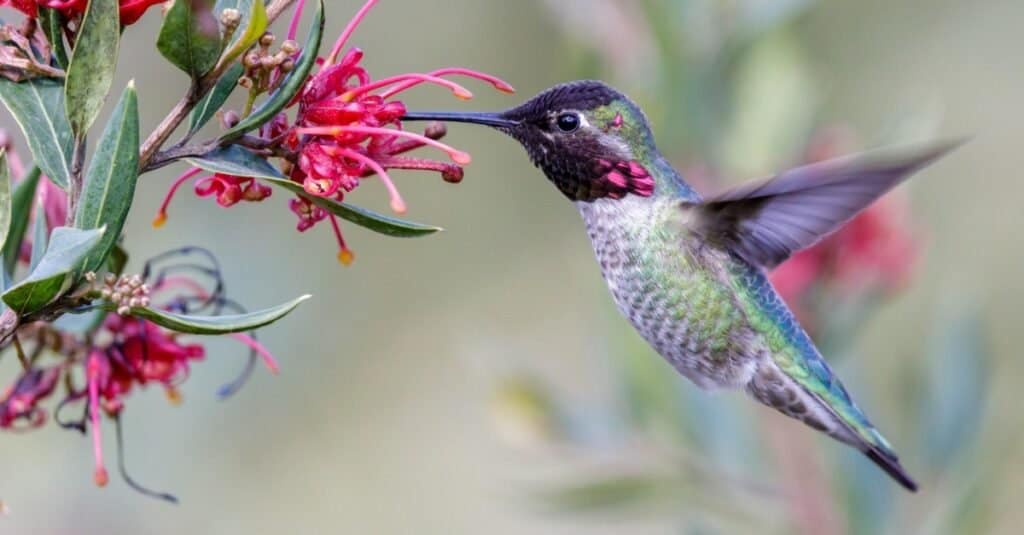
Nectar is an essential food for hummingbirds.
©iStock.com/yhelfman
A hummingbird loves nectar so much that it drinks up to 12 or more times its body weight in nectar every day. So how do they do it? First, hummingbirds visit up to 2,000 flowers per day to find and eat all of that nectar. Second, a hummingbird has a long beak and tongue that helps it reach the nectar deep inside blooms.
Why hummingbirds drink that much nectar daily comes back to their super fast metabolism. The sugar in nectar gives them much-needed energy. And, as we’ve already established, they constantly need more food for energy during the day.
While most of their diet is composed of liquids, hummingbirds also eat solid foods like pollen and tree sap, in addition to eating insects and spiders for protein.
When they’re not busy drinking nectar, hummingbirds often perch on branches, with their long tongues hanging out as they rest and digest their meals.
1. A Hummingbird’s Tongue Coils in Its Skull and Works Like a Sponge
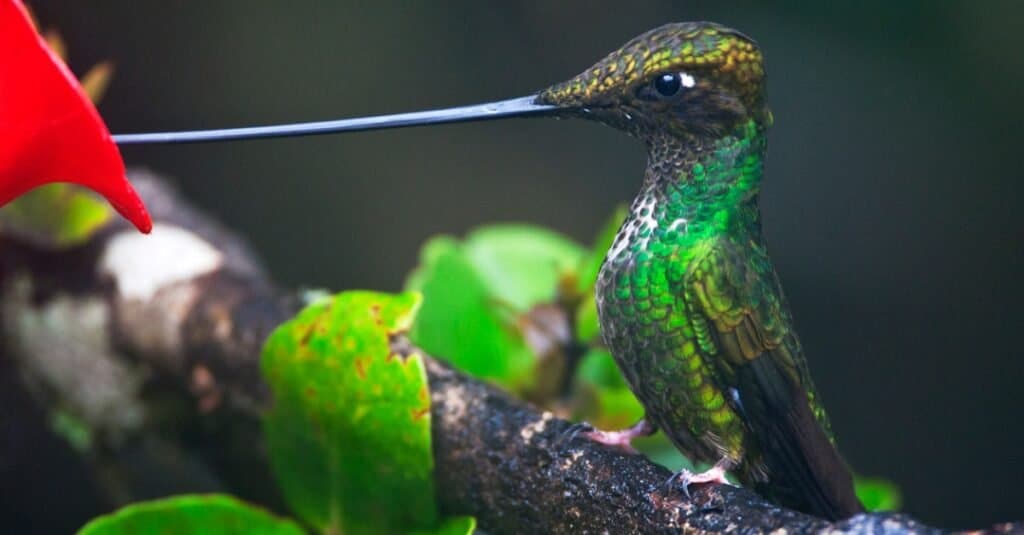
Hummingbirds have tongues almost as long as their beaks.
©iStock.com/AGAMI stock
The tongue of a hummingbird is almost as long as its beak. But its tongue doesn’t stay stretched the length of its long beak when not in use. Instead, when tucked away between feedings, a hummingbird’s tongue coils up inside its head and around its eyes!
In addition to its special way of storing itself, the hummingbird tongue has a unique shape and function. Their long tongue is forked at the end and curled in at the edges. Instead of lapping up nectar, the hummingbird tongue seems to absorb liquid through a mechanism called capillary action. This biological action works like a porous sponge absorbs water. Then their retracted tongue full of nectar releases the liquid down the hummingbird’s throat.
Hummingbirds Are Incredible!

Hummingbirds eat constantly during the day.
©iStock.com/kojihirano
Hummingbirds are fascinating creatures with unique anatomy and skills. Did you already know some of these 10 incredible hummingbird facts, or did we surprise you with a few? There’s no doubt that these tiny birds are experts at flying and drinking nectar, and they have one of the biggest hearts (per body size) of any animal on Earth. In addition, we learned that hummingbirds have an extraordinary tongue and metabolism. And now we know if you want to see a hummingbird, you’ll need to find them in the Americas, where most of these creatures live.
Thanks for learning about hummingbirds with us! For more fun facts about hummingbirds, fly on over to our article about the largest hummingbirds in the world.
Thank you for reading! Have some feedback for us? Contact the AZ Animals editorial team.

